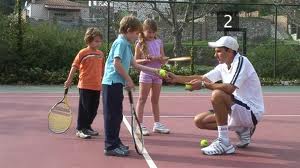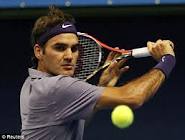Tennis lesson - one mistake after another - corrected!
Not just in tennis, but in many of our daily environments, we are very aware of a mistake. A driver could cut across your path at a roundabout. You might make an aggressive gesture at him. You may just think that he's a guy who should just go back to driving school. How do you best make sure that this sort of mistake is reduced to a minimum?

Hit it over the net
Coaches have to take a lot of responsibility for unconstructive reactions to mistakes in tennis lessons. I have seen so many coaches, more frequently those with big ball baskets, who like nothing better than to stand from close behind the net mouthing things like, "racket back earlier, strike the ball higher, follow through above your head," and similar. Very quickly there is information overload, and the basic shot forms cannot be produced.
I'm exaggerating a little here, to make a point. Many coaches do give pertinent information, at the right time, in the right way. I do want to suggest some improvements to coaches' communication. First of all, coaches should say less. Second, they should say other things.
Say less about a mistake
The USPTR method demonstrates a basic shape and sequence of actions. The coaches must fix themselves on these basic demonstrations, and be rigorous in their application. If a player produces this, and makes a mistake, the coach should, mostly, say nothing. Tennis is a game of mistakes. It is nothing to worry about. Nothing to go giving hefty instructions to your body and mind. The player has received the basic demonstration, so knows exactly what is required. The player must simply do it again until the mistake stops. If the mistakes are excessive then those fundamental actions have not been understood, so the coach has to go back through the actions, possibly one by one. On a groundstroke there are four. It is not too many things to get right!

Feel the length
One of the compliments I paid Federer in a recent article was Federer's attitude to mistakes. He uses them so well to regulate his game, test how he's feeling and moving, test how the conditions need to be adapted to. How can we tell this? This is a player whose basic hitting doesn't change. He is the quintessential rythmn player. He doesn't "hit" so much as, "shape". If that "shape", in all senses of the word, feet, body, racket, dynamics, produces a mistake, the "shape" stays. You can't knock Federer off his "shapes". He simply fine-adjusts them.
Other players "hit". The ball contact itself is overloaded, not the complete shot production. Many players end up by fighting the ball contact, "hitting" harder maybe, starting to give themselves instructions, when in fact the whole package must be reset and retuned from basics upward. Even great players should be able to go back to fundamentals in a flash.
Of course many players do have great "shape" repetition and rythmn, but Federer does it better than anyone.
Finally, let's get back to our coach who has just seen his player make another forehand mistake. If he sees that his player has produced the four fundamentals, his only instruction will be, "let's have another go at that. You nearly got that one."
Have A Great Story About This Topic?
Do you have a great story about this? Share it!
Five of our most popular pages
. tournament win
. finding a sponsor
. the touring pro
. the master at work
